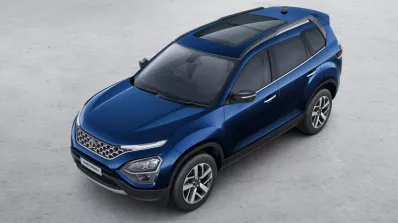2021 Tata Safari - Manual vs Automatic - Acceleration Comparison
Tata Motors recently brought back the iconic 'Safari' nameplate to India with the seven-seater version of the Tata Harrier. The Safari is Tata's new flagship product. Bookings for the new Safari will commence from February 4, before it officially goes on sale sometime later this month. The 2021 Tata Safari will be available in six trims in India - XE, XM, XT, XT+, XZ, XZ+. Prices of the new Safari is expected to range between INR 15-22 lakh and while it is big on style and features, what about performance?
Under the hood, the 2021 Tata Safari is identical to the Harrier. That means it is powered by the Fiat-sourced 2.0-litre, 4-cylinder diesel engine that produces 168 bhp and 350 Nm of peak torque. The engine comes mated to a 6-speed manual or a 6-speed torque converter automatic gearbox. While the older Safari was a proper 4x4, the new model is a front-wheel drive SUV. Here we are comparing the acceleration of the new Safari in its manual and automatic guises to see which comes out faster.
Also Read : Tata Altroz 1.5L Diesel vs 1.2L Turbo-Petrol - Acceleration Comparison
2021 Tata Safari - Manual vs Automatic - Acceleration Comparison
| Tata Safari Manual | Tata Safari Automatic | |
| 0-100kmph (First Attempt) | 11.32 seconds | 10.63 seconds |
| 0-100kmph (Second Attempt) | 10.92 seconds | 10.47 seconds |
| 0-100kmph (Third Attempt) | 10.83 seconds | 10.43 seconds |
As can be seen from the table above, the Safari automatic has come out faster than the manual variant in all the three runs. The best time we managed with the Safari automatic was 10.43 seconds while the manual variant's best was 10.83 seconds. That's a difference of less than half a second. There's thus not much separating the manual and automatic variants of the Safari in terms of performance. That the Safari managed a sub-11 second run with both its gearbox options is also pretty fast for a big three-row SUV.

Just like the Harrier, the Safari too is based on the Land Rover-derived Omega architecture. The new Tata Safari is largely similar to the Harrier in terms of design. However, there are some key differences to note. The Safari boasts an unique grille up front with Tata's signature tri-arrow motifs finished in chrome. There’s more chrome encasing the split headlight clusters. The rear end of the Safari is completely unique with a full rear-quarter glass, a stepped roof, a new tail gate, roof rails and a more upright rear section.
Tata have added 63mm to the Harrier’s length and 80mm to the height to make way for a decent third row. The Safari always had to be a genuine three-row SUV and Tata say that it does not have an apologetic third row of seats. It will come in two seating configurations - a 6-seater with captain seats and a 7-seater with bench seats. Currently, the only rival for the Tata Safari in the Indian market are the MG Hector Plus and the current-gen Mahindra XUV500 as other three-row mid-size SUVs in this class. However, it will soon be joined by the likes of the 7-seater version of the Hyundai Creta and the upcoming next-gen Mahindra XUV500.
Stay tuned to IndianAutosBlog.com for Tata updates more and other four-wheeler news.




















